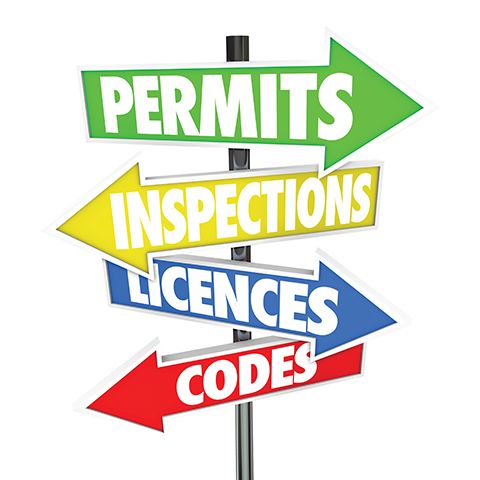Regulatory Issues: The need for sign permits
by all | 29 May 2015 9:06 am
 [1]
[1]Photo by Ingrid, licensed under Creative Commons
By Svetlana Levant
In the past, many signs were installed in Canada without proper permits in place. Today, this situation has changed, as municipal governments are increasingly cracking down on these illegal signs, issuing violation notices and fines to the organizations behind them. This trend appears to be the way of the future and, as such, the need to obtain proper permits through proper channels has never been more important to the sign industry.
Why they’re important
A sign permit is required for most permanent and temporary signs. Municipal governments use permits as an approval process to ensure (a) the size, colour and location of a sign comply with local regulations concerning consistency with the streetscape and (b) the sign’s structural components comply with applicable building codes.
The process to obtain a permit varies in different municipalities. In general, it is getting progressively more detailed and complex. It is fairly standard practice for sign companies to submit an application package that includes several sets of drawings and the intended installation site’s landlord’s authorization. The package typically includes a site plan, elevation drawings and technical structural drawings of all signs involved in the project.
The municipal department in question will then review the application package and drawings to ensure they comply with the local sign bylaw, any zoning regulations pertaining to the site and local building codes. Once the department has reviewed and approved the package, a site copy of the permit is issued.
Failing to obtain the required permits and/or installing signs without a permit can be detrimental to a sign company in many ways. For example, sign companies often rely on a healthy relationship with the municipalities in which they do business. A poor reputation, such as being known for installing illegal signage, can be harmful to a company’s image and will ultimately have a negative impact on that relationship.
There is also an issue of liability. If a sign is installed without a sign permit and the attachments and/or base are not sufficient, then serious harm could occur. Everyone has heard about a sign falling off a wall or being blown away in high winds, presenting real danger to passersby. A sign company can be found criminally negligent if the proper steps were not followed. Going through the permit application process helps ensure a sign proposal is compliant with current building codes with regard to public safety.
 [2]
[2]In Toronto, the municipal government has issued special multimedia permits for signs at and near Yonge-Dundas Square. Several years ago, the area was even designated a ‘special sign district.’ Photo courtesy Samsung
Addressing issues
One of the most common problems cited by sign companies is the length of time it takes for a permit to be issued—anywhere from one to three weeks in typical circumstances, but sometimes several months or longer—depending on the municipality and the time of year.
The best way to expedite the permit issuance process is to ensure the application is complete and accurate, with all of the information the city department is looking for. Helping make the plans’ examiner’s job as easy as possible, after all, will help get the permit as promptly as possible.
It is also strongly recommended for sign companies to do their best in managing their clients’ expectations by emphasizing how time to acquire permits should be factored into the overall project lead time, just as time would be allotted for production, shipping and other steps.
Knowing how to manoeuvre through the permit application process can also help a sign company be ready for otherwise unforeseen challenges. If a building permit is required for a new building, for example, or an occupancy permit for its tenant, then the city will not be able to issue a sign permit for that building or tenant until the other permit has been approved.
 [3]
[3]In general, the process to obtain a sign permit in Canada is becoming more detailed and complex. Image licensed under BigStockPhoto.com
One reason it remains very difficult for sign companies to navigate the permit process, however, is each municipality requires slightly different application information, in a slightly different format. It can take years to become familiar with their bylaws and requirements. Some cities require engineer-stamped drawings, for example, or an engineer’s commitment to a general review, while others require the inclusion of distances between the proposed sign and
the nearest bus stops, traffic signals and/or pedestrian corridors. And rules may constantly be updated and revised.
Also, multiple approvals are often required for a sign, involving transportation departments and heritage conservation authorities, for example. Some of these approvals are handled internally by the municipality, while others may need to be applied for separately. And in some circumstances, an application cannot be submitted before certain approvals are obtained in writing, which can add more time to the process.
Another issue is cost. Each municipality sets its own fees for sign permits and they can vary greatly. Some are based on construction value, some on sign area, while others are simply flat fees. If a sign company does not factor permit costs into its pricing for customers, then this may affect profit margins significantly.
For these reasons, again, it is important to make sure clients appreciate the importance of having a proper sign permit in place. It should be considered part of the project, not merely
an afterthought. Otherwise, any mistakes can become extremely costly. It is far less expensive to do everything right the first time. No one wants to pay to relocate an improperly installed ground sign!
Considering the complexity of sign permit applications and issuances, it may be no wonder some signmakers chose to bypass the process in the past, but as mentioned, times have changed and most municipal governments have become much more rigid in enforcing their sign bylaws’ policies.
Dealing with rejection
When a sign has been installed without a permit, the corresponding municipal department may issue a violation notice and/or fines. In some cases, the city will even remove the sign and charge the owner for both the removal and the subsequent storage. Further, if the enforcing department is aware of illegal signage at a particular site, it can refuse to issue any more permits to the property until the situation is rectified.
Upon receipt of a violation notice, there are typically two options for the sign’s owner: (a) apply for the permit immediately or (b) have the sign removed. The first step in this decision is to check if the sign would be allowed under the current bylaw. If so, then option (a) should work, but in addition to the permit application fee, violation fees may be due and an engineer’s review may be required.
In the case of ground signs, an inspection of the footings is required in most municipalities before the concrete may be poured. If the bases were poured without a permit or inspection, then the city may ask an engineer to sign off on the footings; and for the engineer to see the footings, they may have to be excavated, which will be very costly and disruptive to the client’s business.
Bylaws change over time. Often, a sign that would have been allowed several years ago is no longer permitted today. In retrofit and replacement scenarios, if the original sign did not go through the permit process at the time, then it may well not be compliant with the bylaw.
If a sign is not in compliance with the current bylaw, then the sign company may apply for a special variance or follow option (b) and replace the sign with one that is compliant; either way, there will also be additional costs for the client. Variances are granted based on certain criteria and are never guaranteed, so it is important for both the sign company and the client to be prepared for this outcome and the need to substitute a new, compliant sign. That said, permit specialists are well-versed in sign bylaws and the variance process and may help win approval.
Specialized knowledge
Some sign companies are large enough to establish their own in-house permit application department, which can become familiar with the ins and outs of municipal regulations and approvals. In other cases, sign shops work with experienced outside permit specialists on a project-by-project basis; these professionals not only are generally very knowledgeable about application requirements and time frames, but also have established the right contacts to make the process run more smoothly.
If neither of these options is viable, then it is vital for signmakers to do their own research, educating themselves about their local bylaw’s permit application submission requirements and time frames. This might seem daunting and time-consuming, particularly in terms of taking signmakers’ focus away from what they do best, but in this way, they can pass relevant information along to their clients with confidence.
Finally, with regard to time frames, it is always a good idea to account for a ‘buffer.’ There will often be back-and-forth discussions with the city throughout the permit approval process, so allowing time for this will help manage client expectations.
Svetlana Levant is president of Permit World in Kitchener, Ont., which facilitates the processing of sign-related documents and drawings for municipal permits. She also sits on the board of directors for the Ontario chapter of the Sign Association of Canada (SAC). For more information, visit www.permitworld.ca[4].
- [Image]: http://www.signmedia.ca/wp-content/uploads/2015/05/Headache_billboard_at_Yonge_Dundas_Street.jpg
- [Image]: http://www.signmedia.ca/wp-content/uploads/2015/05/SAMSUNG_238.jpg
- [Image]: http://www.signmedia.ca/wp-content/uploads/2015/05/bigstock-Permits-Inspections-Licenses-66587542.jpg
- www.permitworld.ca: http://www.permitworld.ca
Source URL: https://www.signmedia.ca/regulatory-issues-the-need-for-sign-permits/